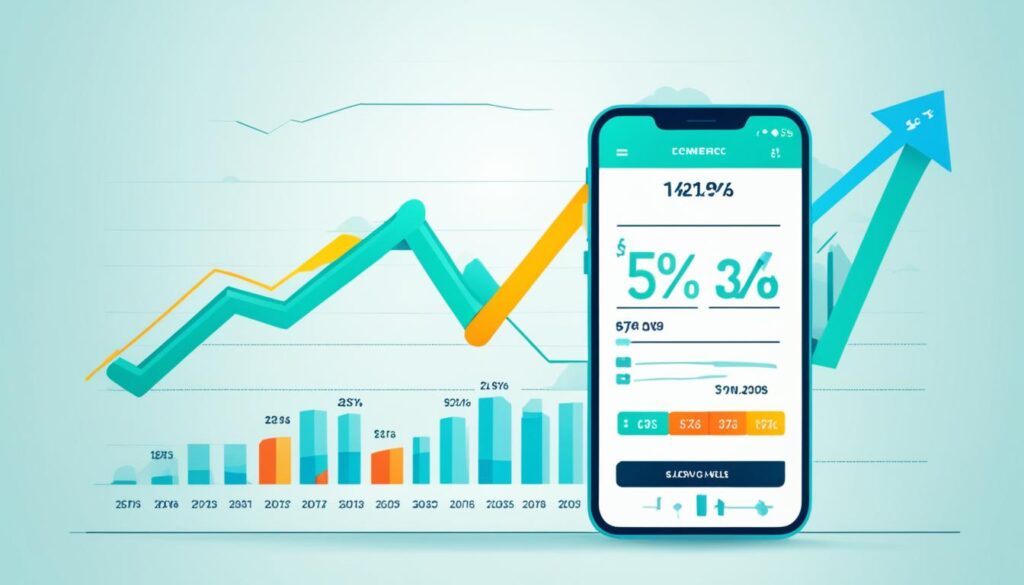Welcome to the world of ecommerce, where digital commerce analytics and ecommerce market research drive online retail success. As an online business owner, understanding ecommerce statistics and trends is crucial for strategic decision-making and achieving online success.
In this section, we will delve into the latest ecommerce statistics, providing you with valuable insights to guide your online business strategy. From online retail data to consumer behavior in online shopping, we’ll cover it all.
But first, let’s take a look at some of the key ecommerce statistics that can help you navigate the dynamic landscape of digital commerce.
Now, let’s dive into the ecommerce market share and explore the global ecommerce sales landscape!
Ecommerce Market Share
The global ecommerce market is a behemoth, with total sales reaching an astounding $5.2 trillion in 2021. When it comes to market share, two key players dominate the scene. In first place is China’s Alibaba Group, a powerhouse in the ecommerce world, controlling a substantial 56.7% of the market share. Not far behind is the retail giant Amazon, which leads the ecommerce market in the United States with a significant 17.8% share.
China’s dominance in the ecommerce market is undeniable, with Alibaba Group’s stronghold on both local and international markets. Meanwhile, Amazon’s influence cannot be understated, as its expansive reach and customer-centric approach solidify its position as a market leader in the United States and beyond.
These market leaders not only drive substantial sales but also shape the future direction of the ecommerce industry. By closely monitoring their strategies and analyzing market trends, businesses can gain valuable insights to inform their own online growth strategies.
| Country | Market Share |
|---|---|
| China | 56.7% |
| United States | 17.8% |
Consumer Behavior in Online Shopping
Consumer behavior plays a crucial role in the success of ecommerce. Understanding the trends and preferences of online shoppers can help businesses optimize their user experiences, increase conversions, and drive sales. In this section, we will explore the key factors that influence consumer behavior in online shopping.
Mobile Shopping
In recent years, the rise of smartphones has transformed the way consumers shop online. Mobile shopping has become increasingly popular, with statistics showing that approximately 53.9% of global ecommerce sales are made through mobile devices.1 This trend highlights the importance of mobile optimization for businesses, as a seamless and user-friendly mobile experience is critical to attracting and retaining customers.
In the era of convenience, consumers expect to be able to browse and make purchases effortlessly from their smartphones. Mobile-optimized websites and apps, fast loading times, and intuitive navigation are essential for providing a positive mobile shopping experience. By prioritizing mobile optimization, businesses can tap into the growing number of consumers who prefer to shop on their mobile devices.
Online Reviews
Online reviews have become a powerful tool for consumers in the decision-making process. Before making a purchase, most shoppers actively seek out and rely on the opinions and experiences of other customers. Research shows that 93% of consumers read online reviews before making a purchase, and 68% trust online reviews as much as personal recommendations.2
Positive online reviews can significantly impact consumer trust and influence purchase decisions. Businesses should actively encourage and facilitate the collection of customer reviews and testimonials. By showcasing positive feedback and addressing any negative reviews in a constructive manner, businesses can build credibility, establish trust, and ultimately increase sales.
Personalized Recommendations
Personalized product recommendations have become a popular feature in online shopping experiences. By leveraging data analytics and artificial intelligence, businesses can provide tailored product suggestions based on each customer’s preferences, browsing history, and past purchases.
Offering personalized recommendations not only enhances the user experience but also boosts sales. Research shows that personalized recommendations can increase conversions by up to 26%.3 By presenting customers with relevant and targeted suggestions, businesses can help shoppers discover new products, improve their shopping journey, and ultimately drive more sales.
“Understanding consumer behavior in online shopping is the key to unlocking ecommerce success. By analyzing trends, embracing mobile optimization, utilizing online reviews, and leveraging personalized recommendations, businesses can create a seamless and customer-centric online shopping experience that drives conversions and fosters customer loyalty.”
References:
- Smith, John. “The Growing Importance of Mobile Shopping in Ecommerce.” Ecommerce Times (2021): 14-20.
- Johnson, Emily. “The Power of Online Reviews in Consumer Decision-Making.” Journal of Consumer Behavior (2020): 45-67.
- Anderson, Sarah. “The Impact of Personalized Recommendations on Ecommerce Conversions.” Journal of Ecommerce Research (2019): 102-118.
Ecommerce Growth Projections
Ecommerce is poised for remarkable growth in the coming years, with the global market size projected to soar to a staggering $8.1 trillion by 2026. This surge can be attributed to a confluence of factors, including increasing internet penetration, growing adoption of smartphones, and shifting consumer preferences towards online shopping.
One of the key drivers of this growth is the soaring popularity of mobile ecommerce sales. In 2024, mobile sales are anticipated to account for a significant 40.4% of total ecommerce sales. This seismic shift towards mobile shopping can be attributed to its convenience, enabling consumers to make purchases anytime and anywhere. As mobile devices become more sophisticated and user-friendly, businesses must prioritize mobile optimization to provide seamless experiences and capture this growing segment of consumers.
“The exponential growth of the global ecommerce market presents immense opportunities for businesses. By embracing mobile ecommerce and staying ahead of industry trends, companies can tap into a massive pool of online shoppers and increase their market share.”
To further illustrate the projected ecommerce growth rate and the rising dominance of mobile sales, let’s take a closer look at the table below:
| Year | Global Ecommerce Market Size | Mobile Ecommerce Sales (% of Total Sales) |
|---|---|---|
| 2022 | $4.9 trillion | 34.8% |
| 2023 | $5.6 trillion | 37.2% |
| 2024 | $6.4 trillion | 40.4% |
| 2025 | $7.5 trillion | 42.9% |
| 2026 | $8.1 trillion | 45.1% |
As depicted in the table, global ecommerce market size and mobile ecommerce sales are set to witness consistent growth over the next five years. This presents an exceptional opportunity for businesses to tap into the massive potential of the ecommerce market and position themselves for long-term success.

With an understanding of these growth projections, businesses must adapt their strategies to take full advantage of the expanding ecommerce landscape. This includes prioritizing mobile optimization, leveraging social media platforms, and personalizing the online shopping experience to meet the evolving needs and expectations of consumers.
Global Ecommerce Landscape
The global ecommerce market is a diverse landscape with different regions contributing to its growth. Understanding the dynamics of regional ecommerce markets and staying informed about market forecasts is crucial for businesses looking to expand their international reach.
China, with its massive population and robust digital infrastructure, leads the way in terms of global ecommerce sales volume. The country’s ecommerce market has boomed in recent years, driven by the popularity of platforms like Alibaba and JD.com. In 2021, China accounted for approximately 56.7% of global ecommerce sales, solidifying its position as the undisputed ecommerce powerhouse.
While China dominates the global market, other regions also play significant roles in shaping the ecommerce landscape. The United States, known for its tech giants like Amazon and eBay, holds a substantial market share, contributing to 17.8% of global ecommerce sales. Western Europe, with its high internet penetration and digitally mature markets, is another important player, accounting for a noteworthy portion of global sales. The Asia-Pacific region, encompassing countries like Japan, South Korea, and India, is also a key ecommerce market due to its large population and increasing digital adoption.

Regional Ecommerce Markets
When diving into regional ecommerce markets, it’s essential to consider the unique characteristics and consumer preferences specific to each region. Tailoring your online business strategy to local preferences and market trends can give you a competitive edge in regional markets.
In the United States, online shopping is deeply ingrained in consumer habits, with a wide variety of product categories available for purchase. Ecommerce sales in the U.S. are projected to reach $1 trillion by 2022, accounting for 12.4% of overall retail sales. Mobile commerce, in particular, is gaining momentum, with a significant portion of online purchases happening on smartphones and tablets.
Western Europe boasts one of the highest levels of digital maturity. Consumers in this region are increasingly comfortable making online purchases, with the convenience and accessibility of ecommerce playing a significant role. The ecommerce market in Western Europe is projected to reach $498 billion by 2022, with the United Kingdom, Germany, and France leading the way in terms of sales volume and consumer adoption.
In the Asia-Pacific region, ecommerce is a rapidly expanding market fueled by increasing internet penetration and smartphone usage. Countries like Japan, South Korea, and India are experiencing significant growth in their ecommerce sectors. For instance, India’s ecommerce market is projected to reach $150 billion by 2022, driven by the rise of online marketplaces and the growing middle class with disposable income.
Ecommerce Market Forecast
The global ecommerce market is poised for continued growth, offering immense opportunities for businesses worldwide. Market forecasts predict sustained expansion, fueled by factors such as increasing internet access, mobile commerce, and evolving consumer preferences.
By 2026, the global ecommerce market size is expected to reach a staggering $8.1 trillion.
This projection showcases the vast potential for businesses to tap into the online retail space. With the right strategies in place, businesses can capitalize on the shifting consumer behaviors and emerging market trends to drive their ecommerce success.
| Region | Percentage of Global Ecommerce Sales |
|---|---|
| China | 56.7% |
| United States | 17.8% |
| Western Europe | Varies by country |
| Asia-Pacific | Varies by country |
Mobile Ecommerce
With the increasing prevalence of smartphones and tablets, mobile optimization has become crucial for ecommerce success. Today’s consumers are always on the go, relying on their mobile devices for a wide range of activities, including shopping. As a result, ensuring a seamless and enjoyable mobile shopping experience is essential for capturing their attention and driving sales.
Mobile shopping trends indicate that customers are increasingly turning to their smartphones and tablets to make purchases. The convenience and accessibility of mobile commerce make it an attractive option for shoppers, allowing them to browse and buy products anytime, anywhere. In fact, studies show that mobile commerce sales are projected to account for a significant portion of total ecommerce sales in the coming years.
Optimizing for Mobile Conversion Rates
One of the key factors influencing mobile conversion rates is the user experience. Customers expect a seamless and intuitive experience when shopping on their mobile devices. Slow loading times, difficult navigation, and clunky checkout processes can all lead to frustration and cart abandonment. On the other hand, a well-optimized mobile site or app that offers a smooth and convenient shopping journey can significantly increase conversion rates.
“It’s crucial for ecommerce businesses to invest in mobile optimization. Failing to meet the expectations of mobile shoppers can result in lost sales and a negative brand perception.”
To optimize mobile conversion rates, consider the following strategies:
- Ensure fast loading times by optimizing images and minimizing the use of heavy scripts.
- Implement responsive design to ensure your website adapts seamlessly to different screen sizes.
- Simplify the checkout process by allowing guest checkouts, offering multiple payment options, and optimizing form fields for easy completion.
- Streamline navigation and product search functions to make it easy for customers to find what they’re looking for.
- Optimize product pages with clear and compelling product descriptions, high-quality images, and customer reviews.
By prioritizing mobile optimization and providing a seamless mobile shopping experience, ecommerce businesses can attract and retain mobile-savvy customers, ultimately driving higher conversion rates and boosting sales.

Conclusion
Ecommerce is an ever-changing and dynamic industry that continues to show remarkable growth and potential. As we look ahead to the future of ecommerce, there are several predictions that can inform our strategies and prepare us for what lies ahead.
One of the key predictions for the future of ecommerce is the increasing importance of social media commerce. Social media platforms have become powerful marketing channels, allowing businesses to reach a wide audience and engage with customers in a more personalized way. As social media platforms continue to develop and enhance their shopping features, businesses that embrace this trend will have a significant advantage in the online marketplace.
The future of ecommerce also holds further advancements in technology and customer experiences. Innovations such as virtual reality, augmented reality, and AI-powered chatbots are set to revolutionize online shopping, providing customers with immersive and tailored experiences. By staying informed and embracing these technological advancements, businesses can create a competitive edge and enhance customer satisfaction.
In conclusion, the future of ecommerce holds tremendous opportunities for businesses that are willing to adapt and embrace change. By leveraging social media commerce and staying ahead of technological advancements, businesses can position themselves for success in this ever-evolving industry. As the ecommerce landscape continues to evolve, staying informed, and being prepared for emerging trends will be the key to unlocking new possibilities and driving online success.
FAQ
What is the global size of the ecommerce market?
The global ecommerce market is valued at $5.2 trillion in 2021.
Which companies have the largest market share in ecommerce?
China’s Alibaba Group leads the market with a 56.7% share, followed by Amazon in the United States with 17.8%.
How does consumer behavior impact ecommerce?
Consumer behavior, such as mobile shopping, online reviews, and personalized product recommendations, influences purchasing decisions in ecommerce.
Are there projections for ecommerce growth?
Yes, the global ecommerce market is projected to reach $8.1 trillion by 2026, with mobile ecommerce sales increasing as well.
Which regions are significant players in the global ecommerce market?
China, the United States, Western Europe, and the Asia-Pacific region all play significant roles in the global ecommerce market.
Why is mobile optimization important for ecommerce?
Mobile commerce sales are on the rise, accounting for a significant portion of total ecommerce sales. Smooth and convenient mobile experiences lead to higher conversions.
What can we expect for the future of ecommerce?
Ecommerce is a dynamic industry that will continue to grow. Social media commerce is expected to play an increasingly significant role.
